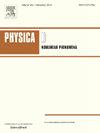An experimental observation of intermittent extreme events in boundary layer transition
IF 2.7
3区 数学
Q1 MATHEMATICS, APPLIED
引用次数: 0
Abstract
One of the fundamental characteristics of an extreme event, which has been widely studied in diverse branches of physics, is the non-Gaussian nature of the probability distribution function. Specifically events which have amplitudes that are twice the significant wave height, which is a measure of the background state, are characterized as extreme events. Here we find a parallel of this event during the laminar–turbulent transition in a flat-plate boundary layer subjected to freestream turbulence. During the transition process spontaneous intermittent turbulent fluctuations are observed with amplitudes twice the significant wave height of the background state. The probability distribution function of events during the transition process is quantified using hotwire anemometry revealing a long-tail non-Gaussian nature as a whole, which is a fundamental characteristic of extreme events. The spatial structure of extreme fluctuation shows that they are large amplitude spatially localized structures which were obtained from simultaneous measurements made using hot-wire and time-resolved particle image velocimetry techniques. The probability of occurrence of such high intensity spatially localized turbulent fluctuations increases with the freestream velocity. Though the phenomenon of intermittency during boundary layer transition has been extensively studied, the objective of the present work is to establish its similarities to extreme events predicted in other fields of physics.

求助全文
约1分钟内获得全文
求助全文
来源期刊

Physica D: Nonlinear Phenomena
物理-物理:数学物理
CiteScore
7.30
自引率
7.50%
发文量
213
审稿时长
65 days
期刊介绍:
Physica D (Nonlinear Phenomena) publishes research and review articles reporting on experimental and theoretical works, techniques and ideas that advance the understanding of nonlinear phenomena. Topics encompass wave motion in physical, chemical and biological systems; physical or biological phenomena governed by nonlinear field equations, including hydrodynamics and turbulence; pattern formation and cooperative phenomena; instability, bifurcations, chaos, and space-time disorder; integrable/Hamiltonian systems; asymptotic analysis and, more generally, mathematical methods for nonlinear systems.
 求助内容:
求助内容: 应助结果提醒方式:
应助结果提醒方式:


